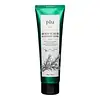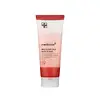What's inside
What's inside
 Key Ingredients
Key Ingredients

 Benefits
Benefits

 Concerns
Concerns

 Ingredients Side-by-side
Ingredients Side-by-side

Disodium Laureth Sulfosuccinate
CleansingJuglans Regia Shell Powder
AbrasiveCocamidopropyl Betaine
CleansingCocamide DEA
EmulsifyingGlycerin
HumectantSodium Chloride
MaskingPunica Granatum Fruit Extract
AntioxidantHoney Extract
HumectantRosa Hybrid Flower Extract
Skin ConditioningPrunus Serrulata Flower Extract
Skin ConditioningChrysanthemum Morifolium Flower Extract
Skin ConditioningCocamide Methyl Mea
Parfum
MaskingTriethanolamine
BufferingLaureth-9
EmulsifyingRosmarinus Officinalis Extract
AntimicrobialChamomilla Recutita Flower/Leaf Extract
AntimicrobialLavandula Angustifolia Extract
Skin ConditioningCentella Asiatica Extract
CleansingMonarda Didyma Leaf Extract
Skin ConditioningCarbomer
Emulsion StabilisingSodium Hyaluronate
HumectantDisodium Lauroyl Glutamate
CleansingAscorbic Acid
AntioxidantPolyquaternium-10
Phenoxyethanol
PreservativeDisodium EDTA
Ethylhexylglycerin
Skin ConditioningDisodium Laureth Sulfosuccinate, Juglans Regia Shell Powder, Cocamidopropyl Betaine, Cocamide DEA, Glycerin, Sodium Chloride, Punica Granatum Fruit Extract, Honey Extract, Rosa Hybrid Flower Extract, Prunus Serrulata Flower Extract, Chrysanthemum Morifolium Flower Extract, Cocamide Methyl Mea, Parfum, Triethanolamine, Laureth-9, Rosmarinus Officinalis Extract, Chamomilla Recutita Flower/Leaf Extract, Lavandula Angustifolia Extract, Centella Asiatica Extract, Monarda Didyma Leaf Extract, Carbomer, Sodium Hyaluronate, Disodium Lauroyl Glutamate, Ascorbic Acid, Polyquaternium-10, Phenoxyethanol, Disodium EDTA, Ethylhexylglycerin
Glycerin
HumectantSucrose
HumectantC12-14 Pareth-12
EmulsifyingSilica
AbrasiveSea Salt
AbrasiveWater
Skin ConditioningButylene Glycol
HumectantParfum
MaskingCaprylyl Glycol
EmollientHydroxyacetophenone
AntioxidantPentylene Glycol
Skin ConditioningCentella Asiatica Extract
CleansingEclipta Prostrata Extract
Skin ConditioningCoccinia Indica Fruit Extract
Skin ConditioningPolysilicone-15
UV Filter1,2-Hexanediol
Skin ConditioningFreesia Refracta Extract
Skin ConditioningMentha Piperita Leaf Extract
Skin ConditioningTocopherol
AntioxidantMonarda Didyma Leaf Extract
Skin ConditioningChamomilla Recutita Flower Extract
MaskingRosmarinus Officinalis Leaf Extract
AntimicrobialLavandula Angustifolia Extract
Skin ConditioningNiacinamide
SmoothingSalicylic Acid
MaskingGluconolactone
Skin ConditioningSaccharomyces Ferment
Skin ConditioningNelumbo Nucifera Leaf Extract
Skin ConditioningCryptomeria Japonica Leaf Extract
HumectantPueraria Lobata Root Extract
HumectantPinus Palustris Leaf Extract
TonicUlmus Davidiana Root Extract
Skin ConditioningOenothera Biennis Flower Extract
AstringentEthylhexylglycerin
Skin ConditioningGlycerin, Sucrose, C12-14 Pareth-12, Silica, Sea Salt, Water, Butylene Glycol, Parfum, Caprylyl Glycol, Hydroxyacetophenone, Pentylene Glycol, Centella Asiatica Extract, Eclipta Prostrata Extract, Coccinia Indica Fruit Extract, Polysilicone-15, 1,2-Hexanediol, Freesia Refracta Extract, Mentha Piperita Leaf Extract, Tocopherol, Monarda Didyma Leaf Extract, Chamomilla Recutita Flower Extract, Rosmarinus Officinalis Leaf Extract, Lavandula Angustifolia Extract, Niacinamide, Salicylic Acid, Gluconolactone, Saccharomyces Ferment, Nelumbo Nucifera Leaf Extract, Cryptomeria Japonica Leaf Extract, Pueraria Lobata Root Extract, Pinus Palustris Leaf Extract, Ulmus Davidiana Root Extract, Oenothera Biennis Flower Extract, Ethylhexylglycerin
Ingredients Explained
These ingredients are found in both products.
Ingredients higher up in an ingredient list are typically present in a larger amount.
Centella Asiatica Extract (Centella) is derived from an herb native to Southeast Asia. It is famous for its anti-inflammatory and soothing properties.
Centella is rich in antioxidants and amino acids, such as Madecassic Acid and Asiaticoside.
Studies show the compounds in centella help with:
The combination of all these properties makes centella effective at soothing, hydrating, and protecting the skin.
Other great components of centella include Vitamin A, vitamin C, several B vitamins, and Asiatic Acid.
Fun fact: Centella has been used as a medicine and in food for many centuries. As a medicine, it is used to treat burns, scratches, and wounds.
Learn more about Centella Asiatica ExtractEthylhexylglycerin (we can't pronounce this either) is commonly used as a preservative and skin softener. It is derived from glyceryl.
You might see Ethylhexylglycerin often paired with other preservatives such as phenoxyethanol. Ethylhexylglycerin has been found to increase the effectiveness of these other preservatives.
Glycerin is already naturally found in your skin. It helps moisturize and protect your skin.
A study from 2016 found glycerin to be more effective as a humectant than AHAs and hyaluronic acid.
As a humectant, it helps the skin stay hydrated by pulling moisture to your skin. The low molecular weight of glycerin allows it to pull moisture into the deeper layers of your skin.
Hydrated skin improves your skin barrier; Your skin barrier helps protect against irritants and bacteria.
Glycerin has also been found to have antimicrobial and antiviral properties. Due to these properties, glycerin is often used in wound and burn treatments.
In cosmetics, glycerin is usually derived from plants such as soybean or palm. However, it can also be sourced from animals, such as tallow or animal fat.
This ingredient is organic, colorless, odorless, and non-toxic.
Glycerin is the name for this ingredient in American English. British English uses Glycerol/Glycerine.
Learn more about GlycerinLavandula Angustifolia Extract comes from the lavender flower. Lavandula Angustifolia is known as the English Lavender and famous for creating purple fields in Provence, France.
Lavandula Angustifolia Extract has anti-inflammatory properties due to its prostanoids and histamine content. Lavender also contains flavonoids and phenolic acids (such as ferulic acid), potent antioxidants.
Lavender extract may have a scent. It contains linalool, a known allergen. However, lavender extract contains less linalool than lavender essential oil.
Learn more about Lavandula Angustifolia ExtractWe don't have a description for Monarda Didyma Leaf Extract yet.
Parfum is a catch-all term for an ingredient or more that is used to give a scent to products.
Also called "fragrance", this ingredient can be a blend of hundreds of chemicals or plant oils. This means every product with "fragrance" or "parfum" in the ingredients list is a different mixture.
For instance, Habanolide is a proprietary trade name for a specific aroma chemical. When used as a fragrance ingredient in cosmetics, most aroma chemicals fall under the broad labeling category of “FRAGRANCE” or “PARFUM” according to EU and US regulations.
The term 'parfum' or 'fragrance' is not regulated in many countries. In many cases, it is up to the brand to define this term.
For instance, many brands choose to label themselves as "fragrance-free" because they are not using synthetic fragrances. However, their products may still contain ingredients such as essential oils that are considered a fragrance by INCI standards.
One example is Calendula flower extract. Calendula is an essential oil that still imparts a scent or 'fragrance'.
Depending on the blend, the ingredients in the mixture can cause allergies and sensitivities on the skin. Some ingredients that are known EU allergens include linalool and citronellol.
Parfum can also be used to mask or cover an unpleasant scent.
The bottom line is: not all fragrances/parfum/ingredients are created equally. If you are worried about fragrances, we recommend taking a closer look at an ingredient. And of course, we always recommend speaking with a professional.
Learn more about Parfum